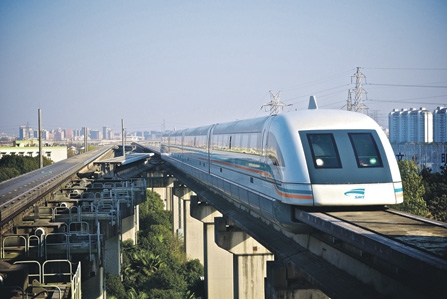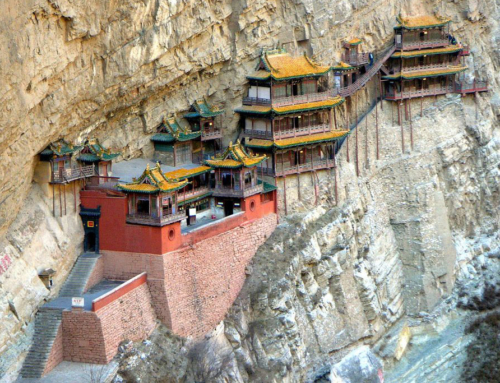Chinese people approve new standard for railways at a speed of 350 kilometers per hour. China started testing of trains at a speed of 1000 kilometers per hour. China doesn’t regret trillion yuan for rebuilding its transport without bothering quick payback of these promising projects. China is testing new high-speed train “Fusin”. Length of new train will be twice as many existing trains – 415 m, and the design speed reaches 350 km per hour. The new train will be able to transport more than 1000 people, writes the Chinese “People’s Daily”. So far, the new high-speed train is being tested in Beijing, reports the manufacturer CRRC Tangshan.
Shortened version of such trains yet used in the Celestial Empire. So since September of last year Chinese high-speed trains “Fusin” started running between Beijing and Shanghai at a speed 350 km/h. But this model of trains can running at a speed 400 km/h.
There has been a real revolution in rail transport in China over the past decade. Today high-speed railway system of China is the longest in the world. So, total length of steel lines exceeded 124 thousand km in China in 2016, 22 thousand of them are high-speed. Wherein total extension of railways increased by 27 km for 5 years in PRC. Over the same period extension of car roads increased by 534 thousand km.
Moreover, China is not only entangling the country with a system of high-speed trains, also it continues to develop its own high-speed magnetic trains. In early 2018, the Chinese company CRRC Qingdao Sifang reported that it was developing its own prototype high-speed maglev with a speed of 600 km per hour. Development must be completed by 2020. In addition, the development of the super-fast maglev continues which can reach speeds of 1000 km per hour. In PRC they noted that it is own original technologies.
Also China engaged in the production of low and medium-speed trains with magnetic cushions. Now this maglev with speed up to 160 km/h are at the pilot production and assembly stage. Main lines of new train`s production will be deployed in Zhuzhou province of Hunan in the middle of 2018 writes the newspaper “Renmin Zhibao” reference to the words of the President of the CRRC Corporation Zhuzhou Locomotive Zhou Qinghe. Previously, such trains accelerated to only 100 km per hour.
But while the train on a magnetic cushion is not too common in the Celestial Empire. Such trains “fly” from Shanghai Pudong Airport, from Changsha Airport and from the Beijing subway. Only the Shanghai maglev can be called high-speed – its maximum speed of 430 km per hour.
The Celestial Empire spends a lot of money on a large-scale infrastructure construction – in just 11 months of last year, China spent 2.12 trillion yuan (323 billion dollars) on all transport infrastructure development projects. Planned indicator for the whole 2017 is 2.6 trillion yuans. This year PRC plans to invest in transport infrastructure no less than last year, told Reuters agency. Chinese intend to introduce another 10 thousand km of expressways until 2020.
The construction of high-speed rail systems is not a cheap pleasure for China. The Chinese will spend 33.53 billion yuan (or 5.3 billion dollars) only on the construction of a new railway with length 92.4 km between Beijing and the new Xiong district in Hebei Province.
Most Chinese high-speed rail lines, which are generously subsidized by the Chinese government, are unprofitable, both in terms of construction and maintenance, as experts recognize.
Also chinese railways company-operator China Railway continues to increase losses, wrote Asian Review. Depts of company amount to 687 milliard yuan in 2007, but this number rose to 4.7 trillion yuan by the middle of 2017. Profitable can be called small routes in industrialized coastal areas such as Beijing-Shanghai, Shanghai-Nanking, Nanking-Hangzhou and Guangzhou-Shenzhen, lists the mass media.
Russia looks more than faded on the background Celestial Empire`s scale plans on developing high-speed rail lines. The construction of the Moscow-Kazan high-speed railway, costing 1.3 trillion rubles, is still in limbo. Moscow-Kazan road was originally planned to be launched for the 2018 World Cup, but in the end this highway did not get into sports budget. Subsequently, the completion dates were constantly postponed. This year is already 2022. High-speed rail system must pass through 7 regions of Russia, which will connecting Moscow, Vladimir, Nizhny Novgorod, Cheboksary and Kazan. Travel time between endpoints should be reduced from 12 to 3.5 hours. It was assumed that Moscow – Kazan would become the first high-speed rail in Russia, along which passenger trains would move at a speed of 350 km per hour.
Russian authorities counted on participation in the project of PRC. At the beginning Chinese side really promised to give Russia a loan of 400 million dollars for construction of high-speed railway. The truth is that the highway should have been built exclusively using Chinese technologies and equipment, but for Russian money.
Later they were thinking about building a part of the high-speed rail segment – from Moscow to Vladimir in the Russian Federation. “The analysis showed that 68% of passengers in our country travel a distance of up to 1,100 km. It would be advisable for them to develop high-speed traffic” explained RZD. At the same time, the monopoly plans to allocate 78.7 billion rubles for the next three years for the construction of the first line of the high-speed rail line before Vladimir. The company is going to invest money on its own, hoping to receive about 180 million rubles from the federal budget. However, even this construction of 180 km of tracks still remains on paper.
In comparison with Chinese success technological lag of Russia is more than noticeable. “And it will only grow. And after seven years, it may become generally insurmountable” does not exclude the managing partner of the Veta expert group, Ilya Zharsky.
Problem of construction of high-speed railways in Russian Federation lies in the underdevelopment of regions. “There is simply no request for so much passenger traffic and at such a high price. For this, we need developed regional capitals” the expert continues.
“Return on the payback of such projects is so difficult that opportunity of their realization turns out to be a huge question. For example, highway Moscow-Kazan can pay off only after 60 years”, thinks the great analyst of TeleTrade Mark Goihman. “On the other hand, you can try to look at our lag optimistically: as in the field of mobile communication and data transmission, it is sometimes advantageous to jump over one or two steps of technological development to build infrastructure on already fundamentally different technologies,” says Ilya Zharsky.









Leave A Comment